

Puerto Rico History. It took seven years to conquer, destroy and enslave the Taino Indians of Boriken.
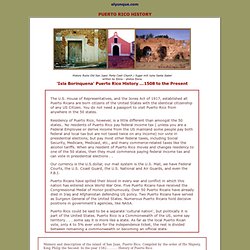
Taken from the first history of Puerto Rico, preserved in the Gutenberg archives. The complete book of Puerto Rican History by R.A. VanMiddeldyk Columbus returned to Spain from his first voyage. He had left behind a small group of men in Hispanola to start a colony. Twenty Granadian lancers with their spirited Andalusian horses were accommodated; cuirasses, swords, pikes, crossbows, muskets, powder and balls were abundant; rice, sugar-cane, vegetables, cattle, sheep, goats, swine, and fowls for stocking the new provinces, and a breed of mastiff dogs, which became in a short time the dreaded destroyers of natives. Spanish Colonialism and Puerto Rican Identity. Spanish Colonialism and Puerto Rican Identity In order to understand the current situation of Puerto Ricans one must look at their history and retrace the sequence of events that led to the current formation of the Puerto Rican people.
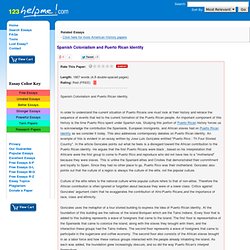
An important component of this history is the time Puerto Rico spent under Spanish rule. Studying this portion of Puerto Rican history forces us to acknowledge the contribution the Spaniards, European immigrants, and African slaves had on Puerto Rican identity as we consider it today. This also addresses contemporary debates on Puerto Rican identity. An example of this is evident in an essay written by Jose Luis Gonzales entitled "Puerto Rico : Th Four Storied Country".
Culture of the elite refers to the national culture while popular culture refers to that of non-elites. Timeline: Puerto Rico. A chronology of key events. 1493 - Voyager Christopher Columbus claims Puerto Rico for Spain. 1508 - Spanish settlement begins; Spanish explorer Juan Ponce de Leon arrives.
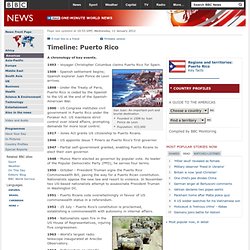
History of puerto rico - Google Search. Puerto Rico History: Timeline. Puerto Rico timeline. Puerto Rico: A Timeline. Puerto Rico History. History of Puerto Rico Timeline - Ask Jeeves. Puerto Rico. History of Puerto Rico. The history of Puerto Rico began with the settlement of the archipelago of Puerto Rico by the Ortoiroid people between 3000 and 2000 BC.
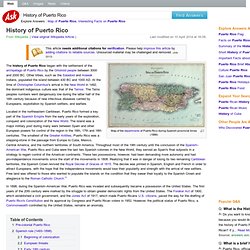
Other tribes, such as the Saladoid and Arawak Indians, populated the island between 430 BC and 1000 AD. At the time of Christopher Columbus's arrival in the New World in 1492, the dominant indigenous culture was that of the Taínos. The Taíno peoples numbers went dangerously low during the latter half of the 16th century because of new infectious diseases carried by Europeans, exploitation by Spanish settlers, and warfare.
Located in the northeastern Caribbean, Puerto Rico formed a key part of the Spanish Empire from the early years of the exploration, conquest and colonization of the New World. The island was a major military post during many wars between Spain and other European powers for control of the region in the 16th, 17th and 18th centuries. Pre-colonial Puerto Rico [edit] Spanish rule (1493–1898) [edit] Beginning of colonization [edit] History of Puerto Rico - XV Century - 1599. Timeline Puerto Rico. Puerto Rico: Maps, History, Geography, Government, Culture, Facts, Guide & Travel/Holidays/Cities. The Commonwealth of Puerto Rico is located in the Caribbean Sea, about 1,000 mi east-southeast of Miami, Fla.

A possession of the United States, it consists of the island of Puerto Rico plus the adjacent islets of Vieques, Culebra, and Mona. Puerto Rico has a mountainous, tropical ecosystem with very little flat land and few mineral resources. Puerto Rico's governor is elected directly for a four-year term. A bicameral legislature consists of a 27-member Senate and a 51-member House of Representatives, all elected for four-year terms. From 1940 to 1968, Puerto Rican politics was dominated by a party advocating voluntary association with the U.S. Under the Commonwealth formula, residents of Puerto Rico lack voting representation in Congress and do not participate in presidential elections.
When Christopher Columbus arrived there in 1493, the island was inhabited by the peaceful Arawak Indians, who were being challenged by the warlike Carib Indians. Since the 1940s, the U.S. History of Puerto Rico I. The Spanish Conquest The Spanish Colony | USA Seizes Puerto Rico The Commonwealth Of Puerto Rico Modern Day Christopher Columbus bumped into Puerto Rico on his second voyage to the new world.
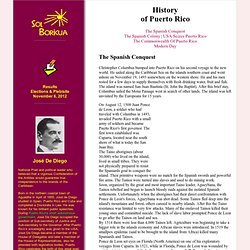
He sailed along the Caribbean Sea on the islands southern coast and went ashore on November 19, 1493 somewhere on the western shore. He and his men rested for a few days to supply themselves with fresh drinking water, fruit and fish. The island was named San Juan Bautista (St. John the Baptist). On August 12, 1508 Juan Ponce de Leon, a soldier who had traveled with Columbus in 1493, invaded Puerto Rico with a small army of soldiers and became Puerto Rico's first governor.